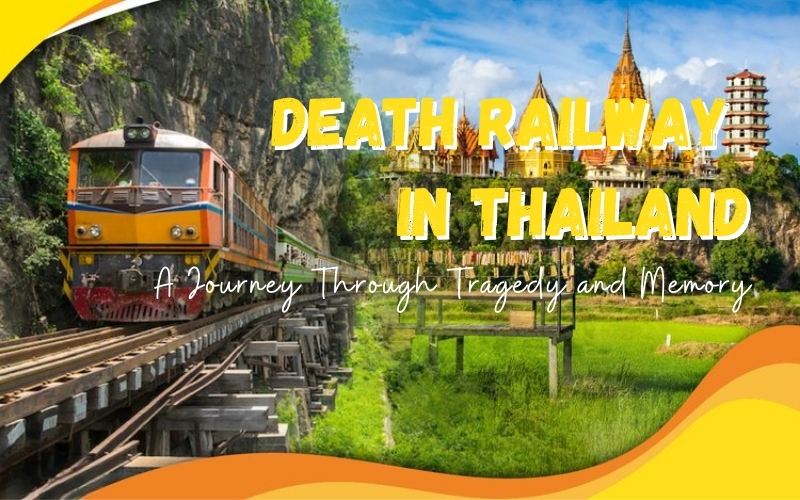
Have you heard of the Death Railway in Thailand? Built during World War II at the cost of thousands of lives, today it stands as both a tragic reminder of history and one of the most historically significant attractions in Southeast Asia. In this article, I’ll walk you through the history, must-see spots, practical travel tips, and how to make your trip more meaningful.
Overview of the Death Railway
If you’ve ever traveled through western Thailand, you’ve probably heard talk of the Death Railway, a now-peaceful landscape that hid one of the darkest chapters of World War II. Stretching through Kanchanaburi province, the railway snakes through jungle, rivers and limestone cliffs, but behind its beauty lies a story of unimaginable human suffering.
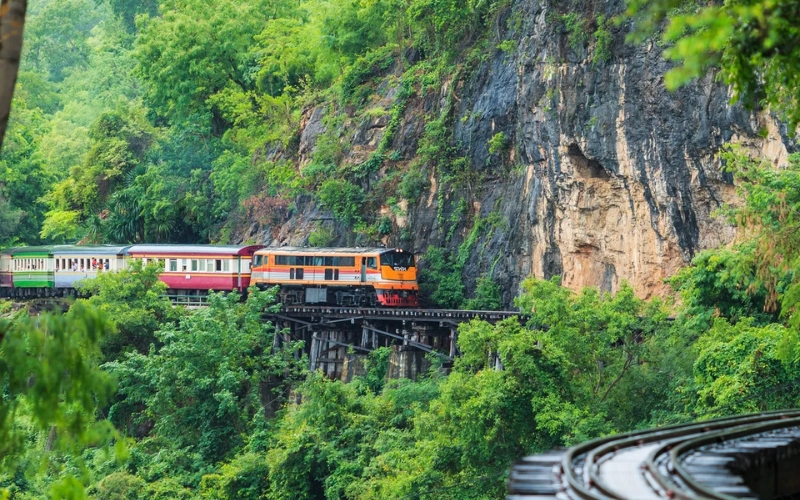
The Death Railway in Kanchanaburi, Thailand
The Death Railway, officially known as the Thai-Burma Railway, stretched for some 415 kilometers from Ban Pong, Thailand, to Thanbyuzayat, Myanmar. Built at breakneck speed during World War II, the railway forced Allied prisoners of war and Asian laborers into forced labor in unimaginably harsh conditions. Thousands died from exhaustion, disease and violence, which is how the railway earned its haunting name.
When I first arrived in Kanchanaburi, I was struck by the contrasts. The lush greenery, the peaceful River Kwai, and the gentle pace of life today made it hard to imagine the horrors that took place here just a few decades ago. As you step onto the tracks, walk across the old wooden bridges, or stand before the memorial plaques, you feel the weight of history.
It is more than just a railway, it is a place of remembrance and a poignant reminder of the human cost of war. Visiting the Death Railway is more than just admiring a historical site. It invites deep reflection, connecting with history in a real and vivid way, and appreciating how time has transformed this once tragic place into a peaceful place.
The Dark Past: History of the Thailand-Burma Death Railway
The Death Railway was built by the Japanese between 1942 and 1943 to connect Kanchanaburi in Thailand with Burma (now Myanmar), supporting their forces in the Burma Campaign of World War II. On paper, it was an ambitious project: more than 415 km of track was dug by hand through mountains, jungles and rivers. In practice, it became a nightmare for the tens of thousands of people forced to build it.
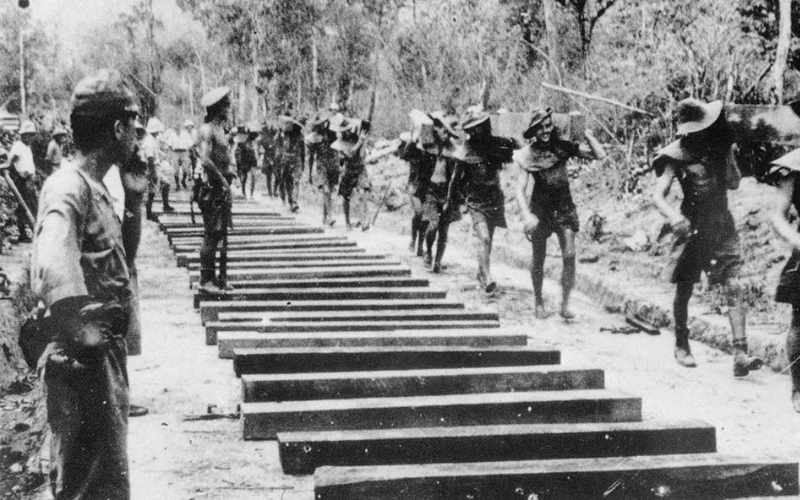
Allied prisoners constructing the Death Railway in 1943
The line was built with forced labor and prisoners of war, 60,000 Allied prisoners of war from the US, Australia, Britain and the Netherlands, and around 100,000 Asian civilians were forced into slave labor to build the railway. During construction, harsh working conditions (high temperatures, lack of sanitation and medical care) led to most of the workers dying from violence, exhaustion or infection. About 80% of the dead were Burmese, Malay and Tamil workers, while the remaining 20% were American, Dutch, Australian, British or Indian. The Kanchanaburi War Cemetery was later built to commemorate the workers who died. The name Death Railway was also officially given.
The railway operated until June 1945, and the border railway lines were destroyed in 1946. Today, the only remaining 130km stretch of the railway in Thailand remains, having reopened in 1957. The railway still traces its origins from the town of Ban Pong, roughly central between Bangkok in the east and Kanchanaburi in the northwest, and ends at Nam Tok – the present-day terminus of the Death Railway, on the edge of Erawan National Park.
> > > If you’d like to explore the Death Railway as part of a wider journey, our carefully designed Thailand tours combine Kanchanaburi’s moving history with the country’s most beautiful temples, beaches, and cultural highlights.
How to get there
The railway is located in Kanchanaburi province, about 130km west of Bangkok, and most visitors start their journey there. You have a few options for getting there – each offering a different adventure.
By train: The most beautiful and authentic way
Basically, the Death Railway departs from Thonburi, or Bangkok Noi, train station in Bangkok. There are two trains a day to Kanchanaburi and Nam Tok. Most day trips from Bangkok usually take the first train at 7:30am and then the second train from Nam Tok at 3:30pm. Don’t expect anything special from this train, as it’s just a very basic train with no air conditioning or even glass windows. There are no assigned seats, but the train wasn’t full when we took the afternoon train from Bangkok to Kanchanaburi. However, be aware that the morning train is likely to be more crowded as most day tours from Bangkok to Kanchanaburi and Nam Tok depart at 7:30am.
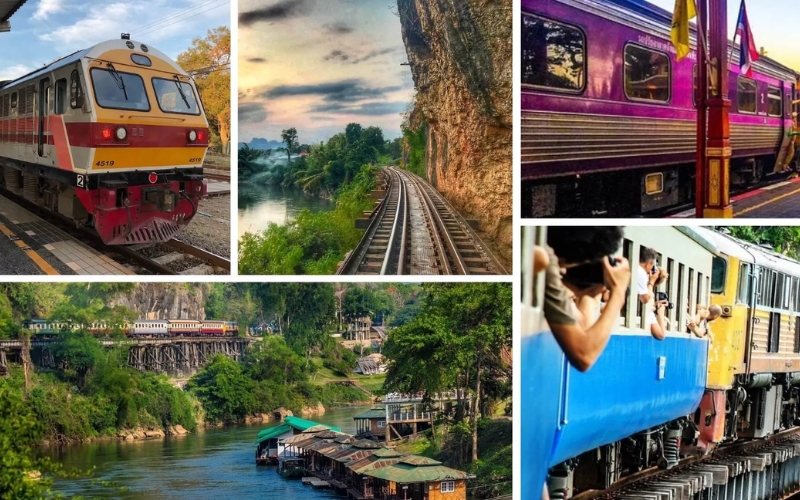
Train journey from Bangkok to Kanchanaburi
The ride is a bit slow and simple, but along the way you will be treated to views of the Thai countryside, rice fields, villages and rivers. When the train finally crosses the River Kwai Bridge, you will feel a hush as people lean out to admire the view. I still remember the heavy feeling when I realized that this railway line cost thousands of lives to build.
By bus or minivan: fast and economical
If you are short on time, buses and minivans are the best option. There are many trips from Bangkok Southern Bus Terminal (Sai Tai Mai) to Kanchanaburi town, which only takes about 2.5-3 hours. From the town center, you can hire a tuk-tuk, taxi, or join a local tour to the railway and surrounding sites. I used to take this route when I wanted to spend more time exploring the museum and war cemetery than taking the train. It was more efficient and affordable.
By private car or tour: flexible and smooth
For a more comfortable experience, many travelers choose a private transfer or organized tour. These tours often include stops at the War Cemetery, Hellfire Pass, and Thai-Burma Railway Center, making it easy to explore and gain a deeper understanding of the railway’s history. When I went with a small guided group, our local guide shared stories that made these sites even more epic, something I wouldn’t have had if I had gone alone.
Must-visit attractions along the Death Railway
Bridge over the River Kwai
The main attraction of this exploration is the 300m-long River Kwai Bridge, part of the Burma Railway, made famous by the 1957 historical film. The bridge was originally built of wood in 1943, but its middle section was destroyed in a bombing raid in 1945, leaving only the original arched spans. After several renovations and repairs, you can now stroll freely and enjoy the view of the River Kwai, where long-tail boats glide below and lush green hills rise in the distance. Street vendors always stand around the bridge area, making it easy to buy food or souvenirs. But remember to quickly find a safe place to stand when the trains appear because they are quite small.
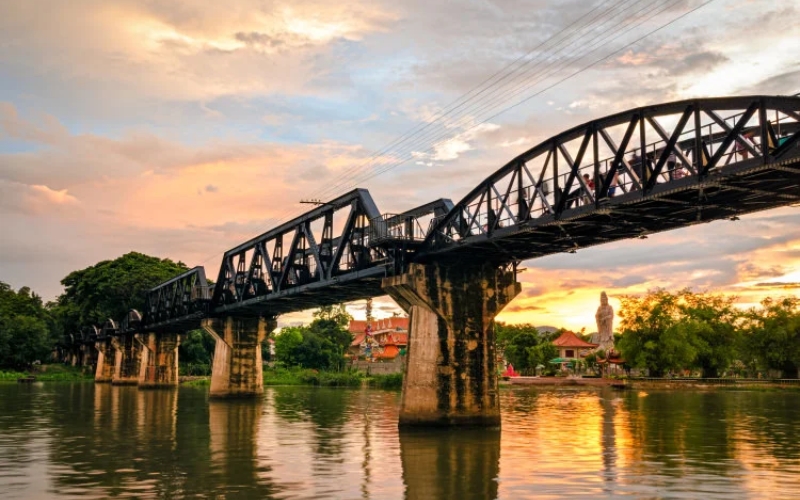
Sunset at the bridge over the River Kwai
If you don’t care much about crowds or noise, come here anytime you want. But my advice is to visit early in the morning or late in the afternoon, when the light is softer and the bridge is quieter. If possible, try taking the train across the bridge, although it is slow and a bit shaky, it adds to the feeling of going back in time. The train windows have no railings. So people lean out of the windows to take pictures and enjoy the view. And we were no exception! Since the train is slow, it is not dangerous at all.
Hellfire Pass
Visiting Hellfire Pass was one of my most moving experiences along the Death Railway. Unlike the famous Bridge Over the River Kwai, Hellfire Pass is more wild and profound. It is here, amidst the quiet hills of Kanchanaburi, that you can really feel the weight of history. On the Death Railway, Hellfire Pass was such a difficult stretch that most of the workers lost their lives here.
As you pass through the cuttings, you will notice how steep and narrow it is. Standing there, it is hard to imagine that this section of rock was dug almost entirely by hand by prisoners of war and laborers. Later, people imagined workers working with torches inside the cuttings as flames from hell. Hence the name Hellfire Pass.
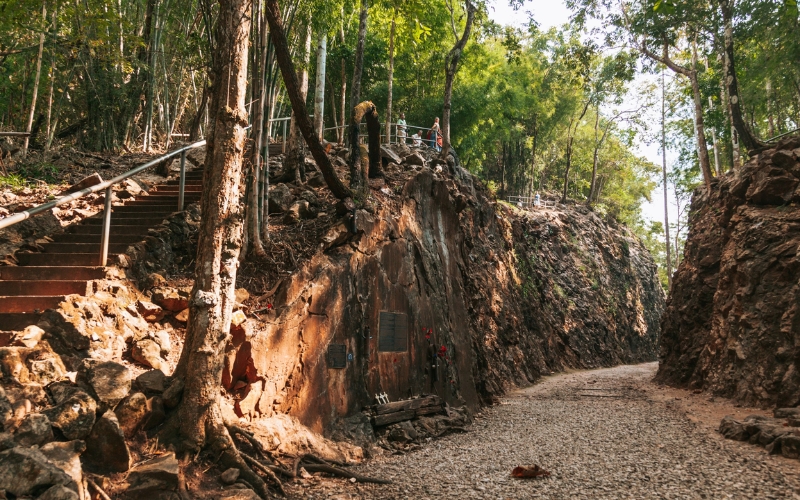
Walking trail at Hellfire Pass Memorial
Today, the pass is part of the memorial trail managed by the Australian government. Hellfire Pass has a trail through the bamboo forest to the memorial. Like other visitors, we walked through the forest slopes to the memorial. The walk was peaceful, surrounded by trees and birdsong, but every few steps you would see plaques and signs explaining what happened here. The atmosphere there was really gloomy, the feeling of witnessing a historical event made me shiver.
Kanchanaburi War Cemetery
The Kanchanaburi War Cemetery, or Don Rak War Cemetery, is often the first stop on a tour. It is where the prisoners of war who died during the construction of the Death Railway are buried and remembered. The atmosphere is solemn and seemingly slow. Unlike the bustling markets or noisy trains nearby, this is a quiet place where even other visitors seem to instinctively lower their voices.
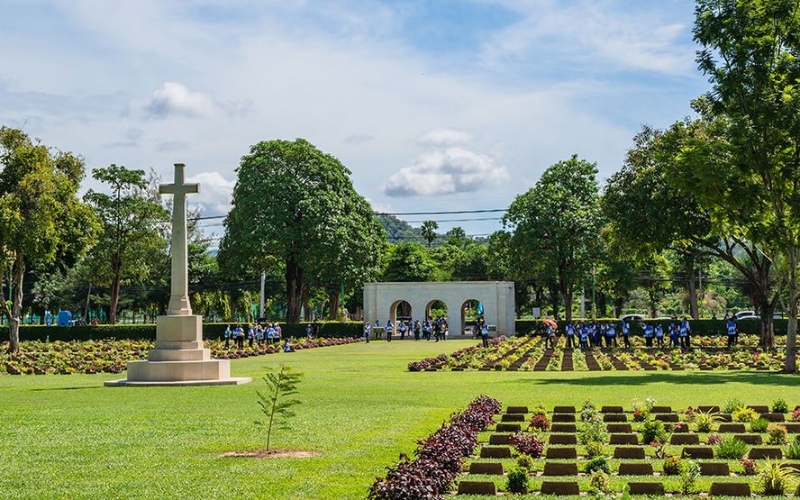
Central Memorial at Kanchanaburi War Cemetery
As you stand among the manicured lawns lined with rows of white tombstones, you can feel the pain and loss of the railway you are about to pass through. But it is also heartwarming to see the families of the soldiers still regularly visit their loved ones. It is a gentle reminder that these soldiers were not just figures in history books, but young men whose families and futures were cut short.
JEATH War Museum
The oldest Death Railway museum, the JEATH War Museum opened in 1977, dedicated to the victims of the Death Railway construction. Alongside artifacts donated by survivors and photo exhibitions, the museum features reenactments that expose the horrific conditions faced by prisoners of war.
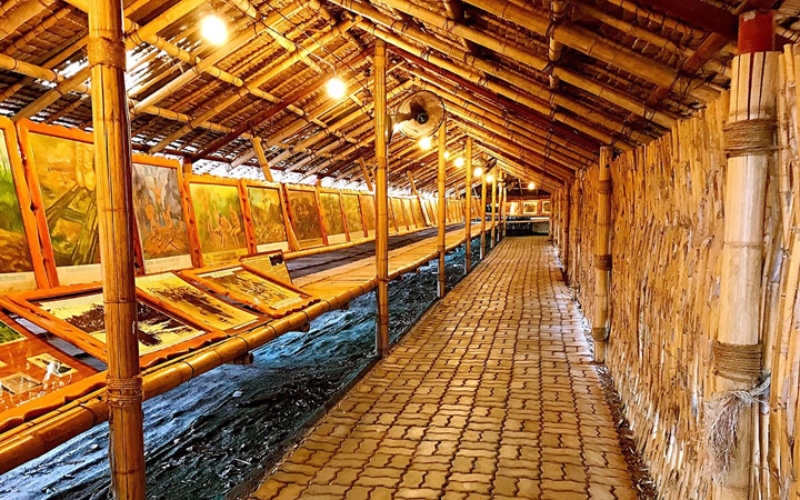
Bamboo Hut Exhibit at JEATH War Museum
This is not a grand or flashy museum like you would find in a big city, and it only takes about 30 to 40 minutes to explore. From the bamboo huts where prisoners lived, the train cars where they were held, to models of harsh working conditions, JEATH brings to life the brutal realities of war. Some of the exhibits are haunting – faded images of emaciated prisoners, shaky handwritten personal letters, and even handmade tools. They tell the story in a very personal and emotional way.
Thai-Burma Railway Centre
Located right next to the Kanchanaburi War Cemetery, the Thai-Burma Railway Centre is a recent museum similar to JEATH. It features a large number of artifacts and information related to the Death Railway, including films and interactive displays documenting the construction of the railway. What impressed me most were the details – handwritten letters, old tools, and even replicas of the cramped huts where prisoners of war lived. Reading about history is one thing, but seeing the artifacts with your own eyes is another.
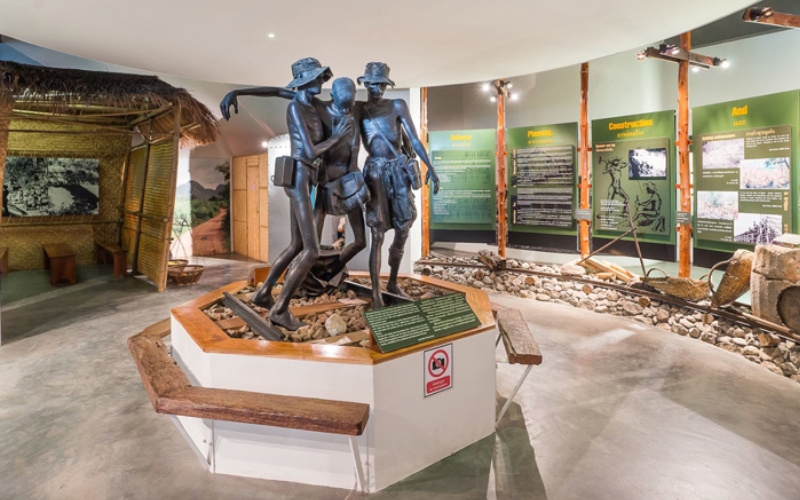
Historical Exhibits at Thai-Burma Railway Centre
Unlike some museums that focus on major events, the Thai-Burma Railway Centre focuses more on individuals. I remember reading stories about Australian and British prisoners of war, as well as Southeast Asian laborers, who endured unimaginable hardships. It was impossible to leave without feeling moved.
Suggested Itineraries: How to Experience the Death Railway
After learning the history and exploring the key sites, the next question is often: how much time should you spend here? To help you plan, I’ve put together some suggested itineraries that will make the most of your visit to the Death Railway and Kanchanaburi.
Itinerary 1
- Day 1: Arrive in Bangkok
- Day 2: Bangkok Temples & Evening Tuk-Tuk Food Tour
- Day 3: Bang Krachao Cycling Tour
- Day 4: Travel to Kanchanaburi
- Day 5: Full-day on Khwae River
- Day 6: Fly to Chiang Mai
- Day 7: Thai Cooking Class & Traditional Massage
- Day 8: Doi Inthanon National Park
- Day 9: Fly to Koh Samui
- Day 10: Ang Thong Marine Park
- Day 11: Koh Samui Free Day
- Day 12: Koh Tao & Koh Nang Yuan Snorkeling
- Day 13: Departure
For a more detailed itinerary, please check this link here.
Itinerary 2
- Day 1: Arrival in Chiang Mai
- Day 2: Explore Hilltop Temples & a Traditional Thai Hill Tribe Village
- Day 3: Travel to Sukhothai, visit Quiet Temples & Sip Local Wine at Baan Umong
- Day 4: Explore Sukhothai’s Rice Paddies & Centuries-Old Craftsmanship by Bike
- Day 5: Travel to Ayutthaya, discover Ancient Ruins and the Ayutthaya Historical Park
- Day 6: Travel to Kanchanaburi, visit the Waterfalls of Erawan Nation Park
- Day 7: Explore the history of the Death Railway, transfer to Bangkok
- Day 8: Explore Bangkok and visit a colorful Floating Market
- Day 9: Depart Bangkok
For a more detailed itinerary, please check this link here.
Some useful tips
After learning the history and exploring the main sites, you’ll want to make sure your Death Railway tour is as meaningful and comfortable as possible. Based on my own trip, here are some essential tips that every traveler should know before going.
- Best time to visit: Thailand has a typical tropical climate and is hot most of the year, so touring the railway in the midday sun can be tiring. I recommend visiting between November and February, when the weather is cooler and drier. If you’re visiting during the hotter months, arrive early in the morning when it’s cooler, and don’t forget to bring water and a hat, you’ll thank yourself later.
- Allow enough time to explore: When I first visited, I underestimated what there was to see. The railway is not just a single bridge – it is an entire area with many historical sites, from the Bridge Over the River Kwai to the Hellfire Pass Memorial. If you only plan a half-day trip, it will be a bit rushed and not enough time to explore. I recommend spending at least a day, or better yet, an overnight in Kanchanaburi so you can explore at your leisure.
- Experience the train ride: Don’t just stop at looking at it from the outside, experience the train ride along the remaining section of the railway. The wooden bridges, the rocks and the river views are stunning. The journey from Kanchanaburi to Nam Tok is the most scenic, and I have to say it is worth every minute.
- Pay a respectful visit to the memorial sites: The Kanchanaburi War Cemetery and the Hellfire Pass Memorial are not just sights, they are memorials. Dress modestly and politely, speak softly, and take the time to read the stories. I found it very moving to see how well these sites were cared for, and it made me think about the human loss behind the railway.
- Hire a tour guide: You can certainly tour on your own, but having a local guide makes a huge difference. With my guide, I heard personal stories of prisoners of war, Asian laborers, and even his own family who were victims of the death railway. It made the facts much more relatable and memorable.
- Follow safety rules: Trains are much safer today, but the tracks around bridges and along the rocks are still a bit precarious. Tourists often stop to take pictures, but don’t linger too long on the tracks, pay attention when a train is approaching, and move to a safe area.
With this guide, you now have everything you need to understand the tragic yet powerful history of Thailand’s Death Railway, and how to respectfully and meaningfully visit its most important sites. From the Bridge on the River Kwai to the Hellfire Pass Memorial, each stop offers an opportunity to reflect on the painful history of war. Contact us today, and we’ll design a trip that combines these moving memorials with the natural beauty and vibrant life that makes Thailand unforgettable.
Read more:
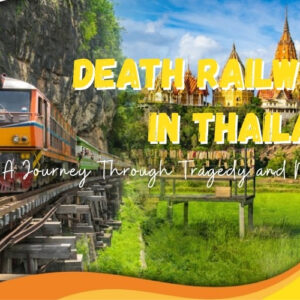
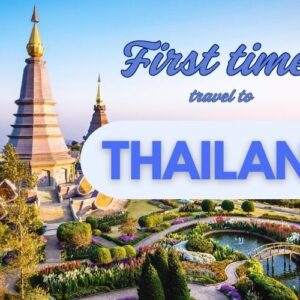

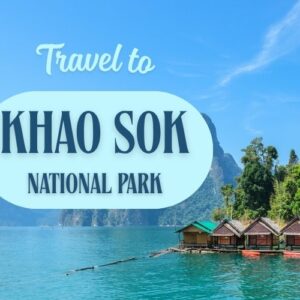
Which part of the railway offers the most beautiful view? Do I really need a tour guide or can I just go by myself?
Definitely the section from Kanchanaburi to Nam Tok. The ride passes wooden bridges, cliffs, and river scenery — it’s the most scenic stretch left. Besides, you can go alone, but having a local guide makes it way more meaningful. They tell personal stories that help you understand the history beyond what’s written on the signs.
Is it possible to visit all the Death Railway sites in one day?
Honestly, it sounds tough. The article says there are many sites spread out across Kanchanaburi, so it’s better to stay overnight if you want to explore everything without rushing.
Are there any tours that include both the Death Railway ride and a visit to the museum or memorial nearby? Would it be worth doing the trip in the late afternoon to catch the evening views?
Yes, absolutely! Many day tours from Bangkok or Kanchanaburi include both the Death Railway ride and visits to the JEATH War Museum or Kanchanaburi War Cemetery. The late afternoon ride is lovely — the soft golden light over the River Kwai makes it extra atmospheric. Just make sure to check the train schedule in advance, as departures can be limited later in the day.